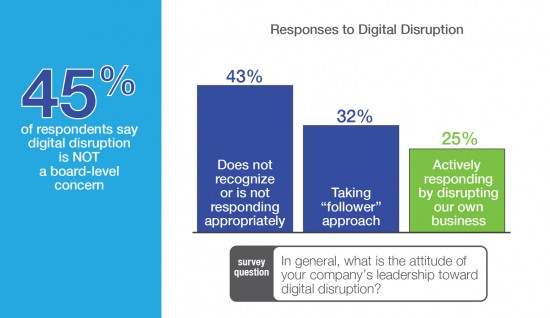While digital disruption is overturning incumbents faster than just about any force in history, many business leaders are not getting the memo.
As I wrote in my previous blog, our recent “Digital Vortex” research found that nearly four in 10 top incumbents will be displaced in each industry due to digital disruption over the next five years. Nevertheless, 45 percent of companies don’t consider digital disruption a board-level concern.
When they do (yes, I see this as a when, not if, scenario), it will be critical for them to see the wider picture and consider some important steps toward digital business transformation. The end goal is to drive their own disruption and compete in the Digital Vortex with the agility and rapid innovation of a startup. To make that happen, top-down leadership is essential.
The stakes are high. The Internet of Everything (IoE) is connecting people, process, data, and things at a breakneck pace, and technologies will continue to collide and fuse in highly disruptive ways. At the center of what we call the Digital Vortex, entire industries are colliding and merging.
After all, who can say to which industry Tesla belongs? Is it automotive, software, energy? It no longer matters. The important thing is that Tesla continues to combine technologies in disruptive ways. Tesla CEO Elon Musk has already challenged GM and Toyota. Next in his sights is utilities, an industry whose executives feel relatively safe from disruption. Those market incumbents should keep a close eye on Musk as his team offers their expertise in energy storage to the home market.
Such rampant disruption sounds like the economist Joseph Schumpeter’s view of capitalism as “creative disruption,” in which the old economic order is perpetually cast off to make room for new sources of wealth creation (my undergraduate senior economics paper was on this topic!).
However, I believe that incumbents can compete like disruptive startups — if they “disrupt themselves” with digital business transformation. This demands that they challenge the assumptions that have underpinned their success. It means changing the organization itself, including its operations, culture, revenue model, and more — in fundamental ways, and perpetually.
How do organizations begin to implement digital business transformation? It starts by addressing the five key questions on our Digital Leadership Checklist:
- Which capabilities are required to increase cost value, experience value, or platform value for customers?
- How can we combine capabilities to magnify the value our customers receive?
- To what degree do we possess these capabilities today? To what degree do competitors — both traditional foes and “over-the-top” players — possess these capabilities?
- If the landscape shifts dramatically due to digital disruption, how quickly can we adapt?
- Are our people, processes, and technology agile enough? How do we increase the agility of our organization to ensure we can fend off (or capitalize on) new disruptions?
These questions will enable leadership teams to develop their approach to digital transformation and innovation — and they demand action. In my next blog, I will drill down on five concrete focus areas that will accelerate the journey to the center of the Digital Vortex

Incumbents have many advantages over startups but ability to change their organisation is not one of them. There are many organisational aspect that can be changed quickly but not organisational culture. Changing the culture takes years. And in my opinion the culture grossly affects the ability of incumbent to become a disruptor and not disrupted
IMO the main move in the playbook is not only agility, but also the willingness to change.
most organizations (and people) stay in their comfort zone and don’t breach out of it enough in order to make the necessary changes.
thats the key to real disruption rather than small incremental changes.